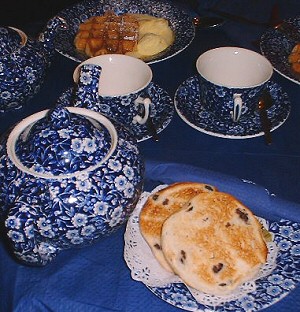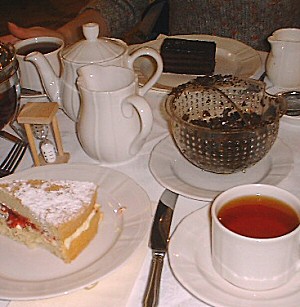Message
Tea in England

Classic English tea table.
So. The English tea ceremony has developed from the English tradition of Afternoon Tea or Five-o-clock Tea. In modern England, perhaps, only in the not so numerous decent tea-rooms, all the rules of the tea ceremony are obeyed — the high pace of life has almost completely ousted this undertaking from both families and public catering.
To conduct an English tea ceremony one needs certain table appointments, tea, snacks for tea, and the ability to manage tea during the process of tea-drinking. Let’s look into these things one after another.
Table appointments. One-color table cloth. White or blue (better white). Disposable cloth is allowed. A small vase with flowers. Better natural and white. A fork and a knife for every tea-drinking person. Serviettes (tissue-paper is possible, to match the table cloth). A tea cup and a saucer, the teapot with tea (either one for all or individual), a jug with boiled water, a jug with milk or cream. A tea-strainer with a saucer for it. Sugar-bowl with lump sugar (ideally — with both white and brown). Tea spoons… Tea snacks, of course, are served in dessert-dishes with fork and knife. All plates and dishes, of course, must belong to one set. China set. White or blue and white (as for me, I like blue and white more). One will also need a quilted or woolen cover — tea-cozy. Tea. Any tea. Usually, guests are offered 5 to 10 kinds of tea. Among which without fail there will be Earl Grey, Lapsang Souchong, Assam, and Darjeeling. And different blends, of course. Heavily flavored teas are also possible, as well as tea bags (they do not make all that good impression though ;). It is very prestigious to have and offer your own specialty tea blend.
Snacks for tea. Snacks for tea are the most difficult part of the English tea ceremony to reproduce in Russian surroundings. On the one hand, English tea pastry does not constitute anything supernatural. It can be easily made at our kitchens — one just needs to get recipes. In the Internet, for example. On the other hand, all their scones, teacakes, ginger cakes, large-cell waffles, creams and jams are very unusual and beyond the bounds of our culinary discourse. Although they are very tasty sometimes — the warm teacakes with salted butter, for example. Ginger bread and cakes are good for emphasizing the taste of tea.
 |
||
| Modern English tea table. | ||
I may make bold to say that it is quite acceptable to change traditional English pastry for our neutral one. Pancakes with caviar will not suit English tea-drinking, of course, but some simple cake will be just right for it. A very simple cake — fancy pastry will suppress tea.
Tea drinking. The main secret of the English tea ceremony is hidden in it, of course. It is a very simple secret, though. Thus. Tea is brewed proceeding from the assumption that when in cups it will not be mixed with water anymore. That is one teaspoon of tea per person. If a teapot is big — for five-six people — one more teaspoon of tea leaves for all (for the pot) may be added. Tea is infused for 3-5 minutes (sometimes a sand glass may be used for control of time — it looks nice), and then poured out into cups. Right after it, hot water from a water-jug is added to the teapot. Teapot is covered with a tea-cozy not to get cold. When tea is brewed for the first time, the teapot does not have to be covered, although it may be.
This water-adding, on the one hand, dilutes tea, which will have drawn by the moment when the first cup will be over. On the other hand, it will keep tea relatively hot and still rather tasty for the repeated drinking. Hot water may be added after the second drinking again — but with every next water-adding the quality of the tea will gradually get worse.
This very hot water adding is the main secret of the English tea ceremony. Simple and pleasant. Pleasant since it can easily be reproduced at home. Try it ;)
Denis Shumakov